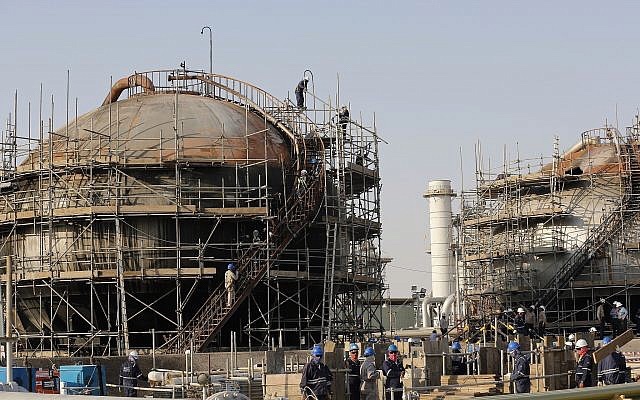By TOI staffToday, 4:38 am
Iran’s Supreme Leader Ayatollah Ali Khamenei personally approved the devastating September 14 combined drone and cruise missile barrage on two Saudi facilities that knocked out half of the kingdom’s oil production, on condition the strike did not target civilians or Americans, the Reuters news agency reported Monday.
According to the in-depth report on the behind the scenes planning for a strike that was intended to punish the US for pulling out of the nuclear deal and imposing strict sanctions on Iran, Khamenei feared that targeting a US base “could provoke fierce retaliation by the United States and embolden Israel, potentially pushing the region into war,” the report said, citing four people familiar with the planning.
Although Yemen’s Iranian-backed Houthi rebels claimed responsibility, the US, Israel, Britain, France, Germany, and Saudi Arabia have accused Iran of being behind the attack. Tehran denies the allegation.
The report describes the deliberations that lead up to the attack, saying it took place in a series of five meetings dating back to May in a heavily fortified compound in Tehran and was attended by senior commanders of the Islamic Revolutionary Guard Corps.

Iranian Supreme Leader Ayatollah Ali Khamenei, right, reviews armed forces with Chief of the General Staff of the Armed Forces Gen. Mohammad Hossein Bagheri, during a graduation ceremony at Iran’s Air Defense Academy, in Tehran, Iran, October 30, 2019. (Office of the Iranian Supreme Leader via AP)
“It is time to take out our swords and teach them a lesson,” one commander reportedly said as hardliners pushed to hit a major target, like one of the US military bases in the area.
Khamenei himself attended one of the meetings.
Ultimately Iran decided to avoid a direct confrontation and attack Saudi Aramco, Saudi Arabia’s state-controlled oil company.
“The group settled on the plan to attack Saudi Arabia’s oil installations because it could grab big headlines, inflict economic pain on an adversary and still deliver a strong message to Washington,” the report said.
Iranian officials denied the Reuters account of the plan and any Iranian involvement.
The report said Iran used 18 drones and three low-flying missiles in the strike and flew them in a “circuitous paths to the oil installations, part of Iran’s effort to mask its involvement.”

Saudi Colonel Turki bin Saleh al-Malki displays pieces of what he said were Iranian cruise missiles and drones recovered from the attack site that targeted Saudi Aramco’s facilities, during a press conference in Riyadh, on September 18, 2019. (Fayez Nureldine/AFP)
Tensions have risen in the Persian Gulf since May last year when US President Donald Trump unilaterally abandoned the nuclear deal between major powers and Iran and began reimposing crippling sanctions in a campaign of “maximum pressure.”
They flared again this May when Iran began reducing its own commitments under the deal and the US deployed military assets to the region.
Since then, ships have been also attacked, drones downed and oil tankers seized.
Iran is unlikely to have been undeterred by increased US troop deployment in the Middle East and remains on track to carry out a large-scale attack in the region, the head of the US military’s Central Command said in an interview published Saturday.
“My judgment is that it is very possible they will attack again,” Gen. Kenneth F. McKenzie told the New York Times.
“It’s the trajectory and the direction that they’re on,” he stated. “The attack on the oil fields in Saudi was stunning in the depth of its audaciousness. I wouldn’t rule that out going forward.”
The lack of serious consequences has led Israeli officials to warn an emboldened Tehran could seek a major attack on the Jewish state soon.
Prime Minister Benjamin Netanyahu last month said Iran was emboldened by the lack of a response to the series of attacks attributed to it. He vowed Israel would respond forcefully to any attack.

In this photo released by the Syrian official news agency SANA, a damaged building targeted by Israeli missile strikes is seen in Qudsaya suburb, western the capital Damascus, Syria, Wednesday, Nov. 20, 2019. The Israeli military on Wednesday said it struck dozens of Iranian targets in Syria, carrying out a “wide-scale” strike in response to rocket fire on the Israeli-controlled Golan Heights the day before. (SANA via AP)
Last Tuesday, Iran’s Quds Force fired four missiles at Israel from Syria, according to the Israel Defense Forces. All four were shot down, and Israel responded a day later with a punishing round of airstrikes against Iranian and Syrian targets.
At least 23 combatants were killed, 16 of them likely Iranians, according to a Syrian war monitor.
Israel has repeatedly said that it will not accept Iranian military entrenchment in Syria and that it will retaliate for any attack on the Jewish state from Syria.
No comments:
Post a Comment